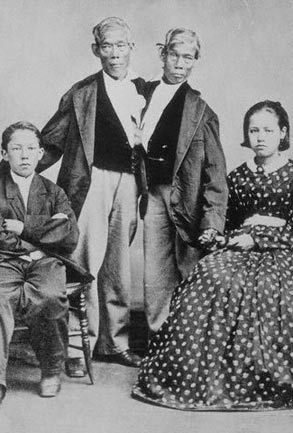Chan and Eng Bunker (แฝดสยามอิน-จัน)

Chan
(Chinese: 昌; pinyin: Chāng; Thai: จัน, Jan, RTGS: Chan) and Eng
(Chinese: 恩; pinyin: Ēn; Thai: อินIn) Bunker (May 11, 1811 – January 17,
1874) were conjoined twin brothers whose condition and birthplace
became the basis for the term "Siamese twins".
Life
The
Bunker brothers were born on May 11, 1811 in Siam (now Thailand ), in
the province of Samutsongkram , to a fisherman and his wife (Nok or
[Nak]; Thai : นาก ). Because of their Chinese heritage (as they were
born from a Thai Chinese father and a Chinese - Malay mother), they were
known as the "Chinese Twins" in Siam. They were joined at the sternum
by a small piece of cartilage.Their livers were fused but independently complete.Although
19th century medicine did not have the means to do so, modern surgical
techniques would have allowed them to be separated.In
1829, British merchant Robert Hunter "discovered" them and paid their
family to let them be exhibited as a curiosity during a world tour.In
1839, while visiting Wilkesboro , North Carolina , the twins were
attracted to the area and settled on a 110-acre (0.45 km 2 ) farm in
nearby Traphill , becoming naturalized United States citizens.Determined
to start living a normal life as much as possible, the brothers settled
on a plantation , bought slaves ,and adopted the name "Bunker". On April 13, 1843, they married two sisters: Chang to Adelaide Yates and Eng to Sarah Anne Yates.This made their respective children double first cousins .In addition, because Chang and Eng were identical twins, their children were genetically equivalent to half-siblings.Their Traphill home is where they shared a bed built for four.Chang and his wife had 10 children; Eng and his wife had 11.In
time, the wives squabbled and eventually two separate households were
set up just west of Mount Airy, North Carolina in the community of White
Plains – the twins would alternate spending three days at each home.During the American Civil War Chang's son Christopher and Eng's son Stephen both fought for the Confederacy.Chan
and Eng lost part of their property as a result of the war, and were
very bitter in their denunciation of the government in consequence.After the war, they again resorted to public exhibitions, but were not very successful.They
always maintained a high character for integrity and fair dealing, and
were much esteemed by their neighbors.The twins died on the same day in
January 1874.They
always maintained a high character for integrity and fair dealing, and
were much esteemed by their neighbors.The twins died on the same day in
January 1874.According to the Travel Channel's "Mysteries at the Museum", Chang suffered a stroke the night that he died.Eng awoke to find his brother dead, and called for his wife and children to attend to him.A doctor was summoned to perform an emergency separation, but he was too late.Eng's widow died on April 29, 1892 and Chang's widow died on May 21, 1917.
 | ||
| In - chan and children of the couple. Memorial
The fused liver of the Bunker brothers was preserved and is currently on display at the Mütter Museum in Philadelphia, Pennsylvania.
Numerous artifacts of the twins, including some of their personal
artifacts and their travel ledger, are displayed in the North Carolina
Collection Gallery in Wilson Library at the University of North Carolina
at Chapel Hill; this includes the original watercolor portrait of Chan
and Eng from 1836.
|

ไม่มีความคิดเห็น:
แสดงความคิดเห็น